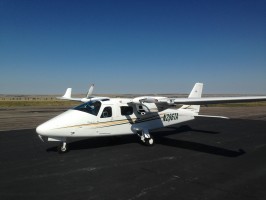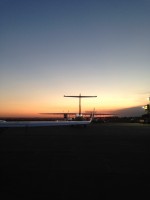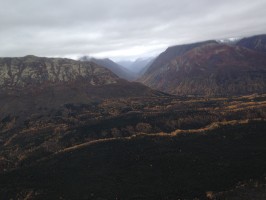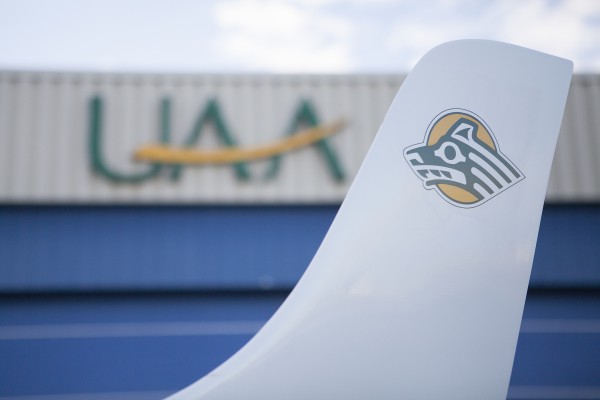Aviation road trip
by joey |
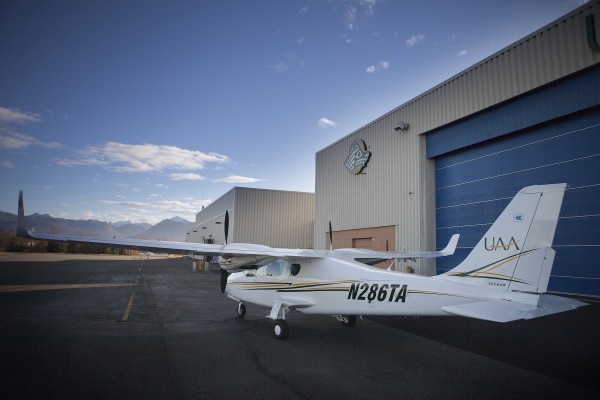
Shipped from Italy, assembled in Florida and painted in Richmond, UAA's new P2006T twin-engine trainer is now safe at home in the Seawolf hangar. (Photo by Philip Hall/University of Alaska Anchorage)
There's a new kid on the block at UAA's aviation campus and he's sleek, young and Italian.
And he's an airplane.
The brand new TECNAM P2006T touched down at Merrill Field earlier this month after a long journey that started at the TECNAM factory in southern Italy. Shipped from Naples, assembled in Florida and painted in Richmond, the new arrival is fresh off a weeklong jaunt across the continent. The twin-engine trainer is now safe and sound at the Seawolf hangar and ready to accelerate the careers of UAA's professional piloting students.
The plane had a long journey from Italy to Anchorage, but an even longer road through development. UAA's Aviation Technology Division has been collecting bids and drafting proposals for over a year and, after narrowing options and researching potentials, the department opted for the TECNAM P2006T. After decades of acquiring used planes, the fuel-efficient twin-engine is the first new plane ever purchased by UAA.
"There are a lot of planes out there that are designed not just as trainers, but also to satisfy a small business use or the private market," explained Rocky Capozzi, director of the Aviation Technology Division. "The plane we bought at TECNAM is really designed from the ground up to be a trainer and to satisfy the FAA's definition for requirements of a twin-engine trainer."
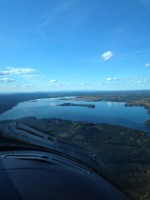
The view over Watson Lake in Yukon Territory during Ash's week-long aviation road trip. (Photo by Ash Burrill)
That's perfect news for UAA students, who spend hundreds of hours working through a number of planes before graduation day. The final step of the ladder is the twin-engine and, prior to the recent purchase from TECNAM, the program had only one twin-engine for students to train on- a 1969 model PA-30 "Twin Comanche" that took its first flight before several students' parents were even born. All UAA planes undergo thorough maintenance every 50 hours of flight time, but the aging Comanche-acquired by UAA in 2005-still requires a bit more TLC. Sometimes the '69 Comanche stayed grounded for days as mechanics searched for discontinued parts to make necessary repairs. With a growing student population, the fleet needed to expand.
"We're having more flying now then they've ever had," explained flight operations general manager Ash Burrill, who arranges training sessions for UAA piloting students. "Part of it is [the number of] students; part of it is streamlining the process and having the right equipment." With an expanded fleet to meet student needs, plus a new online reservation system designed by a UAA aviation student, more students are locking in more hours on more planes than ever before in the program.
"In the last year our graduates are all getting hired with multiple job offers. Every one of them," Ash said. "The demand is there, and the industry's ramping up too."
"My goal is to have three things," he continued. "If I have a plane, an instructor and 4 or 5 blocks a week for each student, I'm seeing that students are finishing their program in 30 to 50 percent less time for each rating."
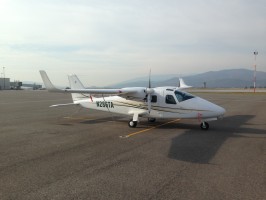
The TECNAM takes another daily pit stop in Missoula International Airport in west Montana. (Photo by Ash Burrill)
The ratings he's referring to are the three levels of planes students pass through in the program. First flights are taken in the fleet of Diamond DA20s before graduating to Cessna 172s. The final tier of the piloting program is the multi-engine, including the Twin Comanche and, now, the new TECNAM.
TECNAM specs
The new TECNAM comes equipped with state-of-the-art navigation and communication tools, including the Garmin 950 GPS system. The multi-screen platform lists everything from upcoming topography to airport approach paths to passing planes in the area. It features a list of every airport in the world-from Sydney to Shaktoolik-and lists the length of each runway and whether it's paved or gravel, lit or dark. Additionally, the GPS provides radio frequencies for ground contacts so incoming pilots can quickly learn surface air pressure and what to prepare for from the folks at the airstrip.
And that's just the GPS.
The engines are another signature feature, boasting fuel economy nearly twice as good as comparable trainers. Most planes rely on high-octane avgas (aviation gasoline) designed specifically for aircraft. The TECNAM, though, can use standard mogas (motor gasoline), which comes with a slew of advantages. "Avgas can be twice the price of normal automotive fuel, so there's a huge price differential between the two," explained Phil Solomon, CFO of Mid-Atlantic Air Ventures-TECNAM's senior sales agent in the States.
Aside from cost, the engines burn less fuel overall. When used for typical training-set routes, including periods with only one engine in use-the plane uses 7.5 gallons per hour of flight. Even on a straight-shot 500-mile flight, the TECNAM would still use only 11 gallons per hour. "When you compare with most typical twins used for training, they'll use between 18 and 20 gallons per hour," Phil said, "And it has to be Avgas."
One more benefit-the mogas-compatible engines are relatively less noisy than their competitors. "From a road perspective, its much quieter," said Phil. "So environmentally it's a good choice, cost-wise it's a good choice and noise wise it's a good choice."
When asked for his favorite features, Ash agreed with Phil-the engines are a huge improvement. "The fuel economy is probably the thing I'm impressed with most, with a close second being the avionics," he said.
Avionics, simply put, are the electronics of aviation. "Avionics are the technological interaction you have with the plane to utilize navigation and communication systems," Ash said. "It's the equipment used to navigate and properly fly the plane." With up-to-date equipment and operating systems, the TECNAM's electric systems are top-of-the-line features that will prepare UAA students for careers in the industry.
"This purchase is beneficial in multiple ways," Ash noted. "It provides students with a more advanced avionics suite, as well as a much different and more efficient multi-engine trainer that they didn't have available prior."
Aerial road trip
As the point person for pilot trainings, Ash earned a trip to Virginia to fly the new addition home to the hangar. A TECNAM rep-Graham Frye-joined him for the ride back to train him on the plane's systems.
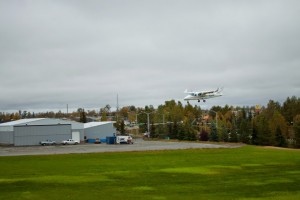
UAA's first-ever brand new plane touched down at Merrill Field on Sept. 18 after five days of flying and over a year of planning. (Photo by Andrew Gichard, Aviation Technology Division/UAA Community & Technical College)
Ash's first stop was the dealership in Richmond, Virginia, where the plane received vinyl striping to match UAA's shades of green and gold. From there, Ash and Graham hopscotched across the continent en route to Anchorage, dipping in and out of airfields and airports in Michigan, Montana, the Yukon and beyond. Despite traveling by plane, their journey still featured the facets of the All-American road trip. Plotting a course through small towns, figuring when (and where) to fill up the tank, programming the GPS and finding a place to stay at the end of the night. The only thing missing was the playlist of drive day tunes, replaced by the crackling code-speak coming through their radios.
Like any good road trip, the plans were pretty fluid-with an advanced communication system in the new plane, it was easy to find alternative airstrips and make appropriate changes. For example, when an oil company snapped up every available hotel room in central Alberta, the pair cut their day a little shorter and pulled into the Edmonton International Airport alongside 747s and cargo carriers.
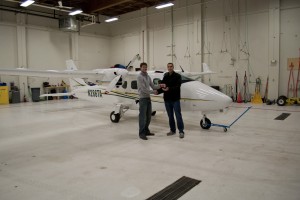
After a week-long road trip together, Graham Frye hands off the keys to the TECNAM P2006T to Ash Burrill in the UAA hangar. (Photo by Andrew Gichard, Aviation Technology Division/UAA Community & Technical College)
Finally, after five days of flying, the TECNAM pulled in sight of Anchorage. Ash called ahead to rally the welcome wagon on campus. "It was quite a lot of fun," he said of the arrival at Merrill Field. "A lot of people from the division came out, especially the flight instructors and the teachers."
It's long journey complete, the new plane is now wrapping up layers of licensing and paperwork (and boasting final Seawolf logos) and will be ready for flight instructors to train on soon. It's fuel-efficient, cost-effective and an overall boon to the aviation division on multiple fronts.
"I would say the number one benefit is having a reliable, cutting-edge-technology trainer that will help [students] transition into their careers and be able to correctly utilize and understand different systems," Ash said.
After spending an entire workweek cooped in TECNAM's cockpit, he's already itching to get the plane out of the hangar and back on the runway for his students to fly.
Welcome home, TECNAM.
Written by J. Besl, UAA Office of University Advancement
 "Aviation road trip" is licensed under a Creative Commons Attribution-NonCommercial 4.0 International License.
"Aviation road trip" is licensed under a Creative Commons Attribution-NonCommercial 4.0 International License.










